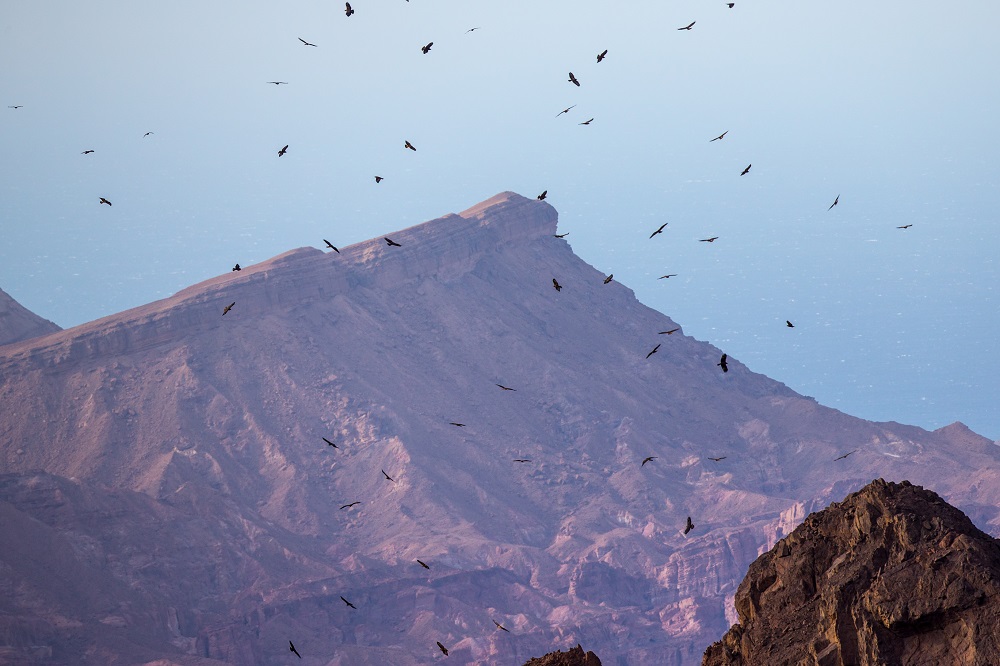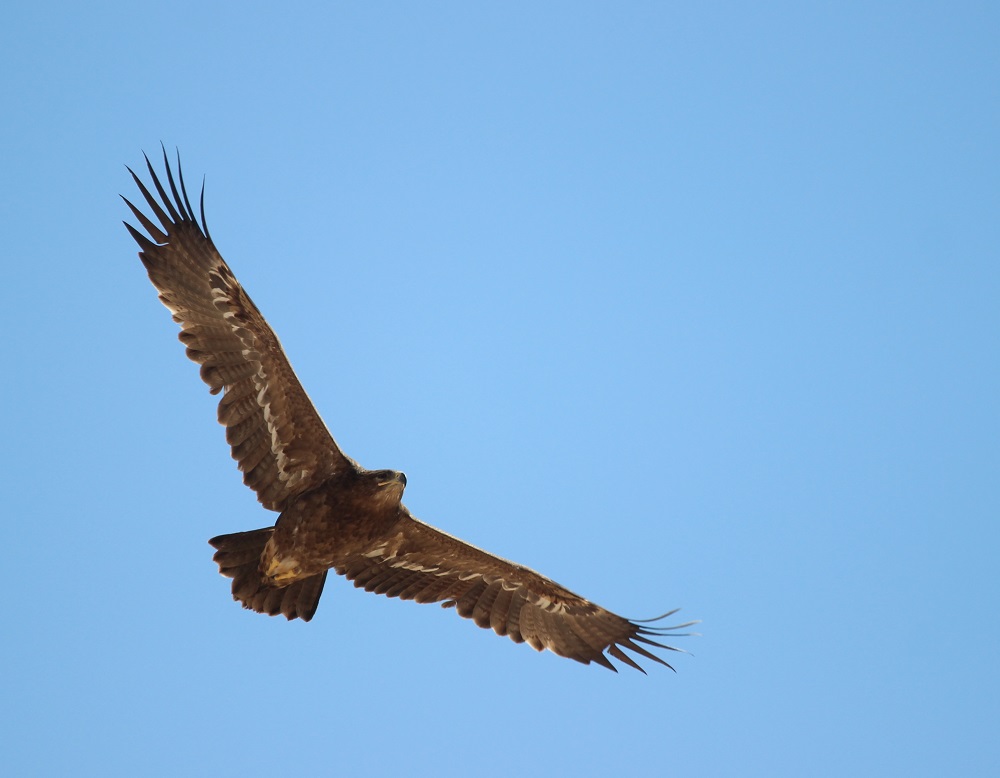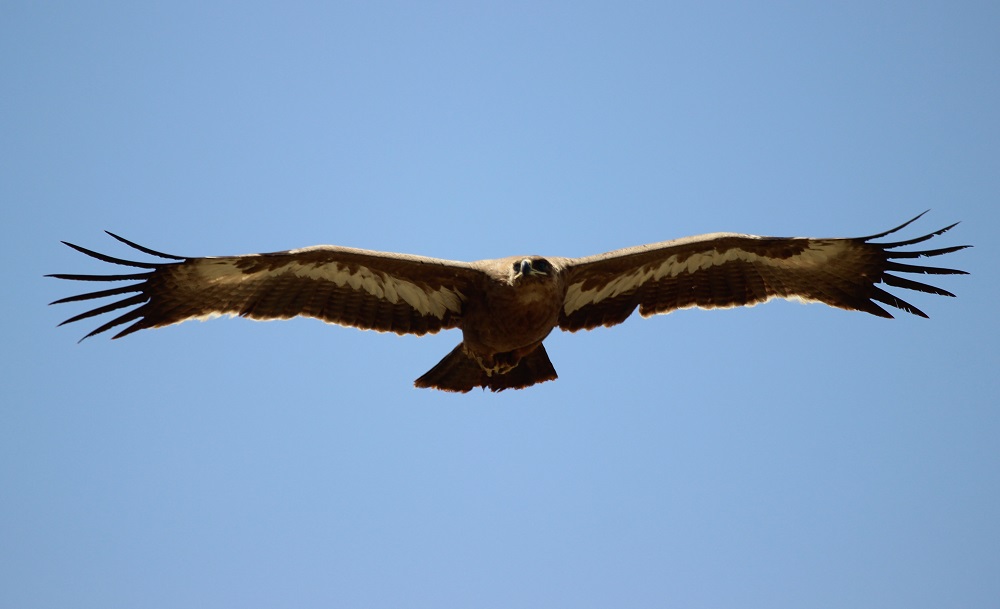Migration time of birdwatchers
At the end of March, the time will have come again. It is the migration time of birdwatchers. From all parts of the world birdwatchers flow to Eilat. They come here just for one reason: The birds fly back to the North and in Israel’s Eilat the birdwatchers celebrate a big birding festival. This year it will take place from the 22nd to 31st of March. In the final competition for the first place in the bird race on the 31st of March all teams collect money for the Steppe Eagle.
With the donations the BirdLife organizations in Kazakhstan and Uzbekistan protect the Steppe Eagle, which is mainly breeding in those regions.
The nature conservationists build elevated nesting platforms and perform educational work among the local people.
Raptors are well the most impressive spring guests in Eilat. Although the record of 850,000 European Honey-Buzzards has not broken since 1985, the big flocks are remarkable again every year. Eilat belongs beside the routes via Gibraltar, the Bosporus and Eastern Turkey to the four main routes for raptors. Especially the thermal gliders, a big proportion of the raptors, look for the shortest way across the sea as they need the warm upwind over land masses. They search straits and the shortest distances across the water, which makes Eilat to a favorite stopover.
HOW EXACTLY DO THE BIRDS OF MIGRATION FIND THEIR WAY?

A built-in navigation
How exactly do the birds of migration find their way? If we summarize it roughly, they see, smell, hear and feel their way. If we look at it in more detail, the following senses and orientations are assumed to play a role for the targeted navigation of the birds: They orient themselves by means of the stars.
If they would have a genetically predetermined star chart they would be lost in the course of the centuries. As the axis for rotation changes very slowly and gradually. It got evident in experiments that birds calibrate themselves step by step and stay adaptive in this way.
In addition to the stars further elements and senses build the framework for the inner compass of the birds. Scientists assume that there is a structure in the eyeball of birds that work similarly like the hand of a sundial. With the shadow on their retina they know where to head to. It is proven among carrier pigeons and assumed among petrels that they also use their sense of smell for orientation.
The majority of bird species probably follows noises. They recognize wetland by the quacking of the frogs, bird calls give additional indications and they recognize mountain ranges by the infrasound or the echo of their own calls. Changes in gravity are other factors to realize the rotation of earth and the direction. Where there is land close by, they see different wave patterns.


Visitors of Eilat
That is how European Honey Buzzards migrate along the coast in a long time as they identify this easily for their orientation. If they come from Northern Europe, nearly 7,000 kilometers distance to Africa lie in front of them. In order to manage this distance on their way there and later back in as long stages as possible they gain in weight by nearly one third of their body weight as reserves before. They usually fly during the day and rest in Eilat until they win height again with the morning winds. As most of them pass first in May when it is already warm in Eilat they start very early in morning dawn.
The season in Eilat starts with the Steppe Buzzard and ends with the Honey Buzzard. In between we might observe different species like the Short-toed Snake Eagle, Egyptian Vultures, Booted Eagles and different buzzards and harriers.
WHILE THE HEN HARRIER WINTERS IN CENTRAL EUROPE, THE WESTERN MARSH-HARRIER, THE MONTAGU’S HARRIER AND THE PALLID HARRIER MIGRATE VIA EILAT TOWARDS SOUTH.
The Steppe Eagle we hear first with its loud flapping before we realize the spectacle in the sky. Ospreys also show up regularly, which master in difference to the thermal gliders persistently huge water surface in their flapping flight. Of help is their broad wingspan of up to 1.70 meters. Their migration behavior is also more broad spread in comparison to the other raptors which limit themselves to small corridors. Neighbors of the breeding area usually winter in big distance of each other and first meet in summer again.
At the Champions of the Flyway in Eilat birdwatchers celebrate all species which pass by. Every species counts. The teams get up before morning dawn and watch birds until sunset. Especially ambitious teams run between their car and the locations for birdwatching to handle many areas, others cycle ecologically from location to location. Winning is not everything in Eilat, even if everyone shows total commitment.

For this year 20 teams have registered: starting with the “Women in Steppe” via “Birding Angola” , the “ZEISS Bespolka Shrikes” and the two-time champions “ZEISSArctic Redpolls” with the Finns, who traditionally take the competition very seriously, up to the resident pupils in the team “Palestine Sunbirds”. In the end it is about the joy of joint birdwatching and about collecting donations for bird conservation.
MORE INFORMATION


